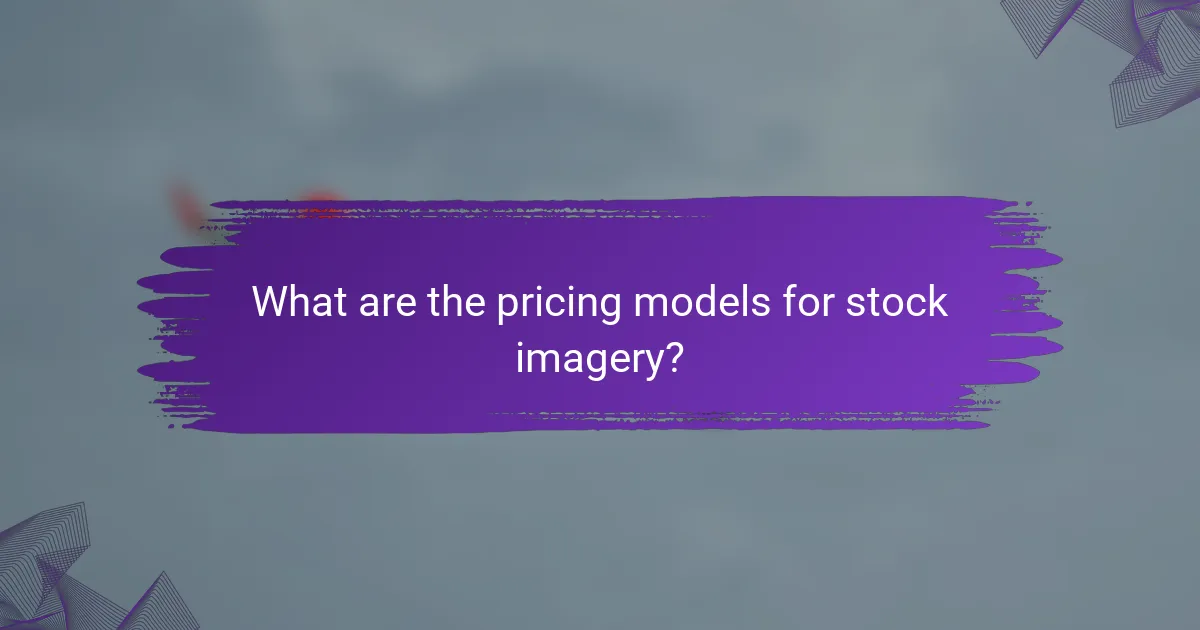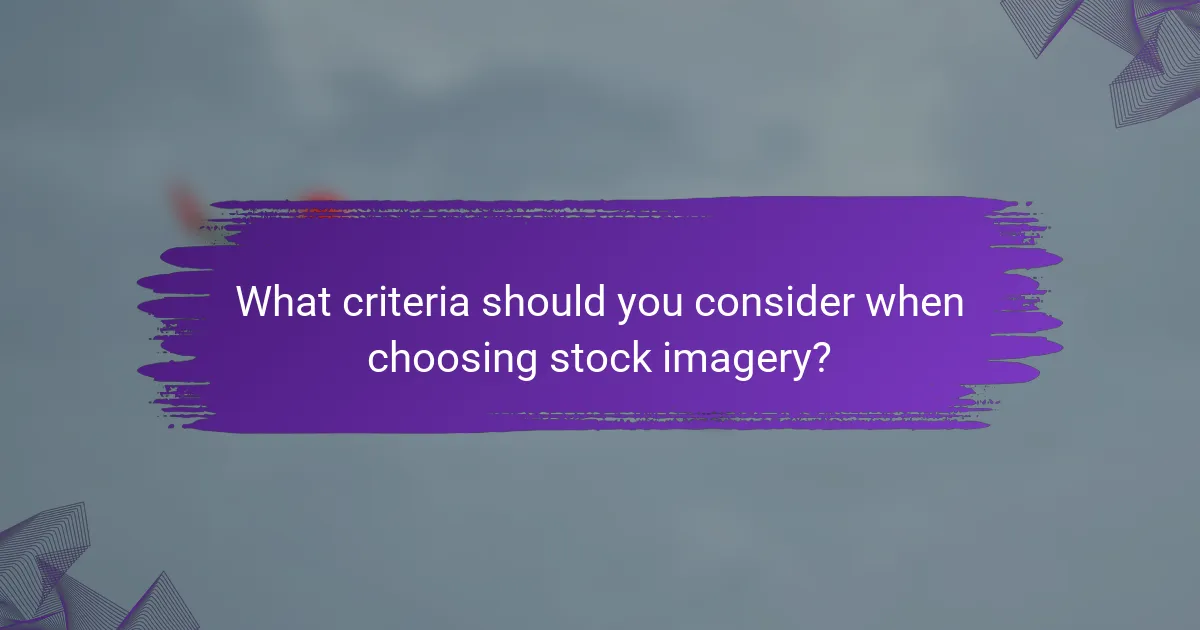The future of stock imagery is being reshaped by changing consumer demands and rapid technological advancements. Trends such as the increasing need for diverse representation, the emergence of AI-generated visuals, and a focus on authenticity are driving the industry forward. Additionally, evolving pricing models, including subscription and pay-per-download options, offer flexibility to users based on their specific needs.

What are the future trends in stock imagery?
The future of stock imagery is shaped by evolving consumer preferences and technological advancements. Key trends include a heightened demand for diverse representation, the rise of AI-generated images, a shift towards subscription models, and an emphasis on authenticity in visual content.
Increased demand for diverse representation
There is a growing expectation for stock imagery to reflect a wide range of cultures, identities, and experiences. This trend is driven by consumers seeking visuals that resonate with their own backgrounds and stories.
Stock image providers are responding by expanding their libraries to include more diverse models and scenarios. Brands that prioritize inclusive imagery can better connect with their audiences and enhance their marketing effectiveness.
Growth of AI-generated images
AI-generated images are becoming increasingly prevalent in the stock imagery market. These images can be created quickly and tailored to specific needs, offering a cost-effective alternative to traditional photography.
While AI can produce high-quality visuals, it is essential to ensure that these images maintain authenticity and relevance. Users should consider the context in which AI-generated images are used to avoid potential disconnects with their audience.
Shift towards subscription models
Subscription models for stock imagery are gaining traction, allowing users to access a broader range of images for a fixed monthly fee. This approach offers flexibility and cost savings for businesses that require frequent access to new content.
Brands should evaluate different subscription options to find the best fit for their needs, considering factors such as image quality, licensing terms, and the size of the image library. This model can streamline the creative process and reduce upfront costs.
Focus on authenticity and real-life scenarios
There is a noticeable shift towards using authentic and relatable imagery that depicts real-life situations. Consumers are increasingly drawn to visuals that tell genuine stories and reflect everyday experiences.
To capitalize on this trend, stock imagery providers are curating collections that feature candid moments and natural settings. Brands should prioritize using such imagery to foster a deeper emotional connection with their audience, enhancing their overall messaging and brand image.

How is technology shaping stock imagery?
Technology is significantly transforming stock imagery by enhancing the creation, discovery, and utilization of images. Innovations such as artificial intelligence, augmented reality, and advanced search algorithms are making stock images more accessible and tailored to user needs.
Advancements in AI and machine learning
AI and machine learning are revolutionizing stock imagery by automating image tagging, categorization, and even creation. These technologies analyze vast datasets to identify trends and preferences, allowing for more relevant image suggestions based on user behavior.
For instance, AI can generate unique images based on specific keywords or themes, reducing reliance on traditional stock photography. This not only saves time but also provides a wider variety of options for creators.
Integration of augmented reality
Augmented reality (AR) is increasingly being integrated into stock imagery platforms, allowing users to visualize images in real-world settings. This technology enables designers and marketers to see how an image will look in context, enhancing decision-making.
For example, AR applications can overlay stock images onto physical spaces through smartphones or tablets, helping businesses choose the right visuals for their projects. This interactive approach can lead to higher engagement and satisfaction with the selected imagery.
Improved search algorithms for image discovery
Enhanced search algorithms are making it easier for users to find the right stock images quickly. These algorithms leverage AI to understand user intent and deliver more accurate search results based on keywords, image attributes, and user preferences.
As a result, users can expect faster access to relevant images, reducing the time spent sifting through extensive libraries. Implementing filters for color, style, or composition can further streamline the search process, making it more efficient for users to locate the perfect image for their needs.

What are the pricing models for stock imagery?
Stock imagery pricing models typically include subscription-based plans, pay-per-download options, and freemium models with premium upgrades. Each model offers different advantages depending on usage frequency and budget, allowing users to choose the best fit for their needs.
Subscription-based pricing
Subscription-based pricing allows users to pay a recurring fee for access to a library of stock images. This model often provides unlimited downloads or a set number of downloads per month, making it ideal for businesses that require frequent access to new visuals.
Common subscription plans range from monthly to annual payments, with prices varying based on the number of images included. For example, a basic plan might cost around $30 to $50 per month for access to thousands of images.
Pay-per-download options
Pay-per-download options charge users for each image they download, making it a flexible choice for those who need images infrequently. This model is straightforward: users select an image and pay a set fee, which can range from a few dollars to over $100 depending on the image’s quality and licensing.
This approach is beneficial for one-off projects or occasional needs, but costs can add up quickly for larger projects. Users should consider their budget and frequency of use before opting for this model.
Freemium models with premium upgrades
Freemium models offer a selection of free images, with the option to purchase premium content. This allows users to access basic stock imagery without any cost, while also providing the opportunity to upgrade to higher-quality or exclusive images for a fee.
While this model is attractive for individuals or small businesses with limited budgets, users should be aware that free images may come with restrictions on usage. Always check the licensing terms to ensure compliance with any limitations on commercial use.

What are the key platforms for stock imagery in the US?
In the US, major platforms for stock imagery include Shutterstock, Adobe Stock, and Getty Images. These platforms offer a variety of images, videos, and illustrations, catering to different needs and budgets.
Shutterstock
Shutterstock is one of the largest stock imagery platforms, providing millions of images, videos, and music tracks. It operates on a subscription model, allowing users to download a set number of assets per month or purchase images on a pay-per-image basis.
When using Shutterstock, consider the licensing options available. Standard licenses cover most commercial uses, while enhanced licenses are necessary for higher-profile projects. Always review the terms to ensure compliance with your intended use.
Adobe Stock
Adobe Stock integrates seamlessly with Adobe Creative Cloud applications, making it a popular choice for designers and creatives. Users can access millions of high-quality images and videos, often with the added benefit of easy drag-and-drop functionality into Adobe software.
Adobe Stock offers subscription plans and credit packs, allowing flexibility in purchasing. Keep in mind that assets can be licensed for various uses, so understanding the licensing agreements is crucial for legal compliance.
Getty Images
Getty Images is renowned for its extensive collection of high-quality editorial and creative images. It caters to professionals looking for premium content, often featuring exclusive images not found on other platforms.
Getty Images operates on a more traditional licensing model, offering rights-managed and royalty-free options. Users should carefully evaluate the licensing terms, especially for editorial use, to avoid potential legal issues. Pricing can vary significantly based on the image’s exclusivity and usage rights.

What criteria should you consider when choosing stock imagery?
When selecting stock imagery, consider factors such as image quality, licensing agreements, and the variety of content available. These criteria will ensure that the images you choose meet your project’s needs and comply with legal requirements.
Quality and resolution of images
The quality and resolution of stock images are crucial for maintaining a professional appearance. High-resolution images are typically at least 300 DPI (dots per inch) for print use, while 72 DPI is acceptable for web use. Always opt for images that look sharp and clear, as poor quality can detract from your message.
Check the image dimensions as well; larger images can be resized without losing quality, while smaller images may become pixelated when enlarged. Aim for images that are versatile enough to fit various formats, whether for social media, websites, or print materials.
Licensing agreements and usage rights
Understanding licensing agreements is essential when choosing stock imagery. Different licenses dictate how you can use the images, such as whether they can be used commercially or modified. Common types include royalty-free and rights-managed licenses, each with its own restrictions and costs.
Before purchasing, read the terms carefully to avoid legal issues. Some licenses may require attribution or limit the number of copies you can distribute. Always ensure that the license aligns with your intended use to prevent potential copyright infringements.
Variety of content available
A diverse selection of stock imagery allows you to find the perfect image for your specific needs. Look for platforms that offer a wide range of categories, styles, and subjects to ensure you can convey your message effectively. This variety can include everything from lifestyle and business images to abstract designs and illustrations.
Additionally, consider the cultural relevance of the images. Stock libraries that feature diverse representations can help you connect with a broader audience. Explore different sources to find unique content that stands out and resonates with your target demographic.

How do trends in stock imagery affect marketing strategies?
Trends in stock imagery significantly influence marketing strategies by shaping brand perception and engagement. As visual content evolves, marketers must adapt their approaches to resonate with audiences and maintain relevance.
Impact on brand storytelling
Stock imagery plays a crucial role in brand storytelling by providing visuals that align with a brand’s narrative. High-quality images can evoke emotions and create connections, making the story more relatable and memorable for the audience.
To effectively utilize stock imagery in storytelling, brands should select images that reflect their values and target demographics. For instance, using diverse and authentic visuals can enhance relatability, while generic images may dilute the brand message.
Marketers should also consider the context in which images are used. Consistency in style and tone across all visual content helps reinforce the brand’s identity and ensures a cohesive storytelling experience.
